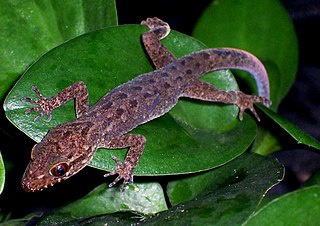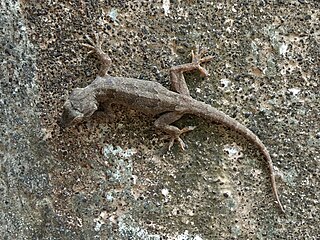
Hemidactylus is a genus of the common gecko family, Gekkonidae. It has 168 described species, newfound ones being described every few years. These geckos are found in all the tropical regions of the world, extending into the subtropical parts of Africa and Europe. They excel in colonizing oceanic islands by rafting on flotsam, and are for example found across most of Polynesia. In some archipelagoes, cryptic species complexes are found. Geckos like to live in and out of houses. They have been introduced to Australia.
Calodactylodes is a genus of lizards, commonly called golden geckos, in the family Gekkonidae (geckos). The genus is distributed in peninsular India and Sri Lanka. Lizards in the genus Calodactylodes are primarily distinguished from other lizards by their characteristic, paired flower petal-like skin extensions on their fingers and toes.

Cyrtodactylus is a diverse genus of Asian geckos, commonly known as bent-toed geckos or bow-fingered geckos. It has at least 250 described species at present, which makes it the largest of all gecko genera.

The Indian golden gecko or Beddome's golden gecko is a species of gecko known only from the Eastern Ghats of India. It was rediscovered from the hills near present-day Tirupati. The rediscovery was after over 100 years since its description.

Leschenault's leaf-toed gecko is a species of gecko, a lizard in the family Gekkonidae. The species is endemic to South Asia and parts of West Asia. It is often found inside homes. Its scientific name commemorates French botanist Jean Baptiste Leschenault de la Tour.

The flat-tailed house gecko, also known as the frilled house gecko or Asian house gecko, is a species of Gekkonidae native to southeastern and southern Asia. The species is sometimes classified under the genus Cosymbotus.
Cnemaspis otai, also known commonly as Ota's day gecko or the Vellore day gecko, is a species of lizard in the family Gekkonidae. The species is endemic to southeastern India.

The rough-bellied day gecko is a species of day geckos found in the Western Ghats of India and Sri Lanka. Its distribution in the southern Western Ghats is patchy and relatively uncommon. It is active during the day. It has a distinct head, elongated snout, and keeled ventral scales; Its dark-brown dorsal side has transverse arrangement of light and dark variegations. It is pale brown/cream on its underside with spiny tubercles on its sides. Males have two to four preanal and three to six femoral pores.

Cyrtodactylus collegalensis, also known as the Kollegal ground gecko or forest spotted gecko, is a species of gecko found in and around Mysore hills, at the junction of the Western Ghats and the Eastern Ghats, in South India. Recent taxonomic works and genetic studies revealed that the formerly-supposed genus is actually a subgenus of the widespread genus Cyrtodactylus. It is often confused with the forest spotted gecko.

Hemidactylus prashadi, also known commonly as the Bombay leaf-toed gecko or Prashad's gecko, is a species of lizard in the family Gekkonidae. The species is endemic to the Western Ghats of India.

The scaly gecko is a species of nocturnal, terrestrial, insectivorous gecko found in South India and northern Sri Lanka. This species was first discovered in the coastal sand dunes of Ramanathapuram in Tamil Nadu. Subsequently, it was incorrectly identified and only recently, elaborate descriptions and molecular data are available, enabling a proper identification.

The common house gecko, is a gecko native to Southeast Asia. It is also known as the Asian house gecko, Pacific house gecko, wall gecko, house lizard, or moon lizard.
Hemidactylus acanthopholis is a species of house geckos from the Tirunelveli in southern Tamil Nadu. Bearing a superficial resemblance to Hemidactylus maculatus, the species is usually found on large rocks or boulders. Growing 20–23 cm (7.9–9.1 in) in length, the species is an overall brown color, but has dark stripes on its back. It takes its name from the warty protuberances running along its dorsal surface.
Cnemaspis adii, also known as Adi's day gecko, is a species of day gecko endemic to Hampi, India. The species was discovered in 2015 by Aditya Srinivasulu and his colleagues in the temple complex.

Dutta’s Mahendragiri gecko is a species of large gecko found in Andhra Pradesh in India.
Treutler's gecko is a species of lizard in the family Gekkonidae. The species is endemic to India.
Ajija’s day gecko is a species of gecko found in India.

The Amboli day gecko is a species of gecko found in India.

Limaye’s day gecko is a species of gecko found in India.

Mahabal's day gecko is a species of gecko found in India.













